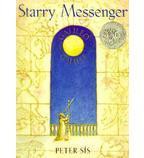Starry Messenger

Peter Sis / Grades 1-2
"If they had seen what we see, they would have judged as we judge." -- Galileo Galilei
In every age there are courageous people who break with tradition to explore new
ideas and challenge accepted truths. Galileo Galilei was just such a man--a genius--
and the first to turn the telescope to the skies to map the heavens. In doing so, he
offered objective evidence that the earth was not the fixed center of the universe
but that it and all the other planets revolved around the sun. Galileo kept careful
notes and made beautiful drawings of all that he observed. Through his telescope
he brought the starts down to earth for everyone to see.
By changing the way people saw the galaxy, Galileo was also changing the way they
saw themselves and their place in the universe. This was very exciting, but to some
to some it was deeply disturbing. Galileo has upset the harmonious view of heaven
and earth that had been accepted since ancient times. He had turned the world upside down.
In this amazing new book, Peter Sis employs the artist's lens to give us an extraordinary
view of the life of Galileo Galilei. Sis tells his story in language as simple as a fairy tale,
in pictures as rich and tightly woven as a tapestry, and in Galileo's own words, written
more than 350 years ago and still resonant with truth.
Standards
|
MST
|
Standard 4: Science
4.1 Physical Setting: The Earth and celestial phenomena can be described by principles of relative motion and perspective.
|
ELA
|
Standard 1: Language for Information and Understanding
1.1 Listening and Reading: Listening and reading to acquire information and understanding involves collecting data, facts, and ideas; discovering relationships, concepts, and generalizations; and using knowledge from oral, written, and electronic sources.
Standard 2: Language for Literary Response and Expression
2.1 Language for Literary Response and Expression: Listening and reading for literary response involves comprehending, interpreting, and critiquing imaginative texts in every medium, drawing on personal experiences and knowledge to understand the text, and recognizing the social, historical and cultural features of the text.
|
Social Studies
|
Standard 2: World History
2.1 The study of world history requires an understanding of world cultures and civilizations, including an analysis of important ideas, social and cultural values, beliefs, and traditions. This study also examines the human condition and the connections and interactions of people across time and space and the ways different people view the same event or issue from a variety of perspectives.
2.2 Establishing timeframes, exploring different periodizations, examining themes across time and within cultures, and focusing on important turning points in world history help organize the study of world cultures and civilizations.
2.4 The skills of historical analysis include the ability to investigate differing and competing interpretations of the theories of history, hypothesize about why interpretations change over time, explain the importance of historical evidence, and understand the concepts of change and continuity over time.
|


